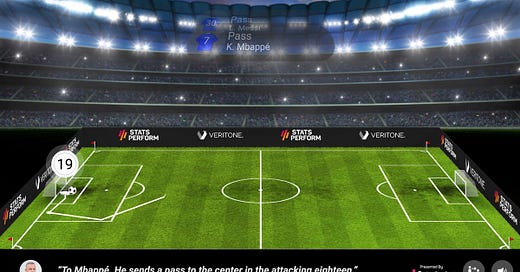Veritone Provides Synthetic Announcers for a New Type of Sports Broadcast
Giving sports data from Stats Perform a voice
If you were going to start a new sports news media business, would you hire announcers? This is the question Stats Perform recently confronted. The company already had a solution that would write stories in natural language based on sports facts and stats. Opta Voice, the new collaboration between Veritone and Stats Perform, provides sports and sporting event coverage using synthetic announcers that sound like the real thing.
Stats Perform, and many of their customers do not have broadcast rights or video feeds to show sporting events live. However, they do have in-depth data from the events. That includes everything from in-game statistics to where the players and the ball are at any given moment.
This data stream means they can offer a play-by-play of the action similar to a radio broadcast but with a couple of added benefits. For one, the company can also create a synthetically generated visual picture of the pitch, field, or court to accompany the stream.
Beyond Radio and TV
If you ever watched the old Major League Baseball game broadcasts from the MLB.com website, you will have a good sense of how this looks. There was some digital representation of a player at bat, and you would see the stats refresh every 30 seconds or so. On-screen, you would see key stats for the game as well as for the at-bat.
This was not as immersive as watching the game live, but when you could not see the game on television, it was a decent alternative. The stream also provided details you would not get from a television broadcast and much more than you heard on the radio. However, there was no play-by-play audio.
Opta Voice
The Opta voice solution mines the Stats Perform game data to offer the on-screen stats along with a human-sounding synthetic text-to-speech voice of an announcer. AI not only generates the voice but also the natural language generation of what is happening in the game.
If fans are watching, they see the ball move around the football pitch with visual indicators of which player has the ball and where it came from. That is accompanied by a spoken play-by-play, and the virtual announcers can even offer color commentary. You can see an example below.
In and Beyond the Telecast
When is this useful? When you don’t have access to the broadcast is just one example. Even if they are watching, some viewers may appreciate the in-game stats. And the service will enable viewers to watch the telecasts in their preferred language.
The broadcaster in this scenario doesn’t have to field announcers in every native language of its viewership. Veritone Voice AI can deliver speech-to-text in multiple languages. In addition, the voice can be completely novel or a voice clone of a real-life announcer.
Patrick Fischer, Chief Business Officer at OneFootball commented, “We believe content that drives engagement and adds to our vertically integrated product will give our fans a reason to return to our app many times per day. Realistic and scalable audio content can play an important role in this strategy.”
Opta Voice is also suggesting other use cases for recorded media, such as social media posts along with podcast and radio content. Since you don’t have to have a human record the script, you can increase the production efficiency and generate more content overall. In addition, it can be in multiple languages and localized by simply changing the text-to-speech script and creating other versions.
This is a new product, and its popularity with sports enthusiasts is still untested. However, it is yet another example of how synthetic media offers novel ideas around content production and presentation.
$$$ Beyond the Content
The content angle has clear value for publishers — more content, more engagement, more users, and so on. However, Veritone is thinking beyond the synthetic voice to monetization. The solution can also generate ad revenue with live ad reads from another synthetic voice (similar to radio or podcasts). Veritone also has plans to enable users to mint videos or stills of game experiences as NFTs.
I’m sure there will be more to come on these options as the solution matures. Hyper-automation will generate more content and that content may, in fact, drive direct revenue. Wouldn’t that be nice.
You can read full coverage of this announcement on Voicebot.ai.







Aren't the left and right wings reversed in this play call ?